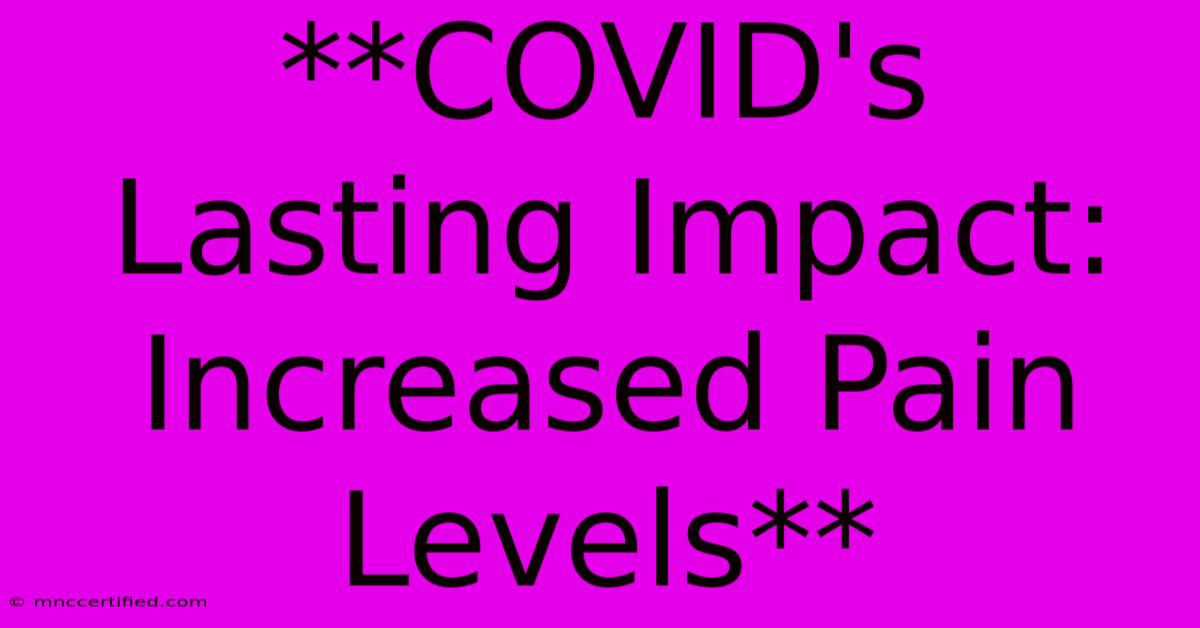**COVID's Lasting Impact: Increased Pain Levels**

Table of Contents
COVID's Lasting Impact: Increased Pain Levels
The COVID-19 pandemic has left an indelible mark on our world, impacting not only our physical health but also our mental well-being. While many associate COVID with respiratory complications, a growing body of research suggests a long-term impact on pain levels, a phenomenon known as post-COVID pain.
Understanding Post-COVID Pain
Post-COVID pain refers to persistent pain that develops after recovering from COVID-19. This pain can be new or worsening of pre-existing pain, and it can affect various parts of the body.
What makes post-COVID pain unique?
- Prevalence: Studies indicate that a significant percentage of people who have had COVID-19 experience persistent pain.
- Persistence: The pain can persist for weeks, months, or even years after the initial infection.
- Variety: Post-COVID pain can manifest in various forms, including:
- Musculoskeletal pain: Pain in muscles, joints, and bones
- Neuropathic pain: Pain caused by nerve damage
- Headache: Chronic headaches and migraines
- Fibromyalgia: A disorder characterized by widespread musculoskeletal pain and fatigue
- Chronic fatigue syndrome: A condition marked by persistent fatigue and other symptoms
Potential Causes of Post-COVID Pain
While the exact mechanisms behind post-COVID pain are still under investigation, several theories are being explored:
- Viral persistence: The virus may linger in the body, triggering inflammation and pain.
- Immune dysregulation: COVID-19 can disrupt the immune system, leading to chronic inflammation and pain.
- Neurological changes: The virus may affect the nervous system, causing pain signals to be amplified.
- Mental health impact: The stress and anxiety associated with COVID-19 can contribute to pain perception.
Living with Post-COVID Pain
Managing post-COVID pain can be challenging, but there are strategies to help:
- Medical evaluation: Seek a medical professional to rule out other causes of pain and receive personalized recommendations.
- Pain management techniques: Treatments may include medications, physical therapy, cognitive behavioral therapy, and lifestyle changes.
- Support groups: Connecting with others who have experienced similar pain can provide valuable support and resources.
Research and Awareness
Ongoing research is crucial to better understand post-COVID pain, develop effective treatments, and improve the quality of life for those affected.
Raising awareness about this long-term consequence of COVID-19 is essential to ensure that individuals receive the appropriate care and support they need.
If you are experiencing persistent pain after recovering from COVID-19, please consult with your healthcare provider.
Keywords: post-COVID pain, COVID-19, long-term impact, pain management, pain relief, persistent pain, chronic pain, neurological changes, immune dysregulation, viral persistence, medical evaluation, research, awareness, healthcare provider, support groups.

Thank you for visiting our website wich cover about **COVID's Lasting Impact: Increased Pain Levels**. We hope the information provided has been useful to you. Feel free to contact us if you have any questions or need further assistance. See you next time and dont miss to bookmark.
Featured Posts
-
The View On Trump Win Abc Live Stream
Nov 07, 2024
-
Arsenals Rice Out For Inter Milan Chelsea Hope
Nov 07, 2024
-
Uefa Youth League Aston Villa Thrash Brugge
Nov 07, 2024
-
What Is Project 2025 And Trumps Stance
Nov 07, 2024
-
Prop 36 Passes California Criminal Justice Reform
Nov 07, 2024